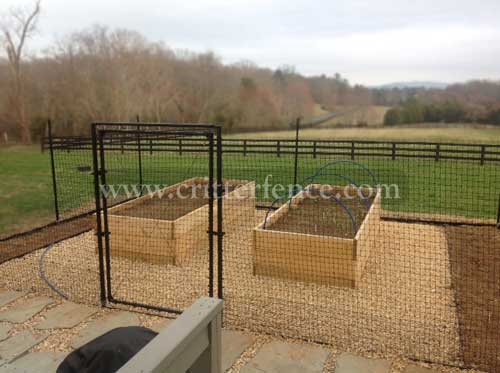How To Deer Proof Your Garden
Jan 25th 2018

How to Deer Proof Your Garden with Fencing
If you garden in deer country you know that deer love to eat the plants that you love to grow! The only certain way to keep deer out of a garden or yard is by installing deer proof fencing.
For more information besides what is found on this page, please visit our garden fence page: deer fence photo - what is a deer fence?
A single deer, or more often, a deer herd passing by can do significant damage in a short amount of time. Each mature white-tailed deer can eat 7 to 10 pounds of plant material per day.
Deer love spring shoots. They will feast on summer flowers and vegetables. Then in the winter will graze on shrubs. If hungry enough, deer will even eat plants considered to be deer resistant - especially when areas are covered by snow.
You can prevent some damage by planting deer resistant plants. Other options include anti-deer sprays, noise makers and motion sensor lights.
But the best way to keep out deer is to install a fence. There are many factors to consider when choosing deer proof fencing.
Fence Height
Deer will jump over common garden fences. A deer proof garden fence should be at least 7 feet in height. For very small areas like a 25 x 25 garden area, 6 foot high fences can be adequate in some areas with light deer pressure.
Invisible Deer Fence
Deer are more likely to jump a garden fence if they can sense how high the barrier is. Wooden top rails can give deer the perfect sight line to allow them to jump and are not recommended! This includes chain link fences with a top rail.
Polypropylene & Metal Fencing
Polypropylene (known as poly) fences or metal fences are nearly invisible. Choosing invisible fences gives you flexible options to fence greater portions of your yard. Invisible deer fences won't block your view or detract from the look of your garden.

Pictured: In this garden area, the top fence material is polypropylene plastic paired with a smaller opening metal base. A tubular metal frame using the same fencing material to cover it acts as the garden fence entrance and exit gate.
Fence Material
The less expensive deer fence choice is polypropylene fencing (poly fencing). Poly fencing is used to fence entire yards or create small garden enclosures. It can be used for temporary installations such as protecting fruit trees that are beginning to fruit. Choose rounded strand poly fencing with a strength of 650 pounds per square foot or stronger.
Another effective choice is metal deer fencing. While still invisible, metal deer fencing is fitting for more longevity or when your goal is to keep out other animals that chew. To keep on budget try a combination of a tall poly fence with metal fencing. The metal fencing will deter small animal traffic or animals that chew.
Electric fencing is better suited to keep large domestic animals inside a fenced area. It's not appropriate for keeping out deer. Domestic animals can be trained with electric fence; wild animals cannot.
Fence Opening Size
Choose a fence with openings 1 inches or smaller to keep out rabbits and raccoons. Deer fencing should always be 2 inches or smaller. Larger openings can cause deer to become entangled and injured.
Keeping Out Small Animals
To prevent small animals burrowing into your garden, you should consider six or more inches of fence pinned down into the earth and angled towards the outside of the fence. For critters that can climb, consider a fence that can have a top barrier that tilts out to prevent entry. For small burrowing animals like moles, bury the fence a minimum of 12" in the ground.
Fencing Poles and Support
Some poly fencing is so easy to install that you can use existing trees as support. This is useful if you are planning to enclose a large area. Permanent poles and supports are best for smaller enclosures such as around vegetable gardens. Seek out fencing that offers ground sleeve systems for fence poles. This gives gardeners the opportunity to install fencing that is seasonally removable. This a great way to move fencing to different areas throughout the seasons. Ground sleeves also offer more strength and leverage as opposed to putting posts directly in the ground.
Gates
Imagine coming out of your garden, arms full of tools, or baskets of vegetables! With this in mind, make sure you plan your fences with gates at convenient intervals. Place one gate heading towards the garden shed and one towards your kitchen. Choose a gate system that is secure yet easy to open.
Make the investment now to protect your and garden with invisible deer fencing. It will ensure future seasons of bountiful gardens. Happy gardening!
